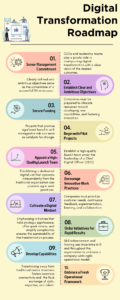As businesses adapt to evolving customer behaviors and integrate new technologies, one essential aspect stands out as critical for success: data and digital transformation.
Anticipating market shifts and meeting customer demands are critical in the current market. Understanding how to effectively utilize data and digital transformation is fundamental to achieving favorable results.
This article explores the fundamental components of data and digital transformation, emphasizing the significant role played by data and outlining strategies for businesses to leverage it for informed decision-making, actionable insights, and the development of customer-centric approaches. These initiatives ultimately lead to improved customer experiences and operational efficiency.
To navigate their journey of data and digital transformation, businesses are increasingly seeking assistance from reliable partners such as Technoforte. With its established reputation, Technoforte is dedicated to empowering organizations, enabling them to harness the potential of data and technology for successful and transformative outcomes.

The Pivotal Role of Data and Digital Transformation
The significance of data and digital transformation cannot be overstated; it represents a revolution in modern business practices.
Embarking on a journey towards successful data and digital transformation requires businesses to acknowledge the pivotal role of data, which serves as the cornerstone and driving force behind this evolution.
It’s not merely about adopting the latest digital technologies; rather, it’s about making decisions informed by data that can catalyze widespread change throughout the organization.
Initiatives for Data and Digital Transformation
Achieving successful digital transformation initiatives is intricately connected with data. This process commences with a thorough understanding of the current state of affairs, encompassing business processes, customer behaviors, and the quality of data. Such comprehension forms the basis upon which a robust strategy for digital transformation can be constructed.
Data doesn’t merely shape your strategy; it defines it. Establishing a clear data strategy creates a roadmap for effectively harnessing the power of data, ensuring that every action taken aligns with your business objectives.
It serves as the guiding compass for navigating your journey of transformation in the digital realm.
Utilizing Data for Creative Advancements
The challenge in innovation lies in the absence of a universal solution. Each product or service demands its distinct approach, and this is where data becomes instrumental.
Data analytics offer insights into customer behaviors, aiding in the identification of popular products and emerging opportunities. With data, you can consistently stay ahead in innovation, tailoring your offerings to meet the evolving demands of the market.
Ultimately, innovation isn’t solely about being inventive; it’s about being innovative at the opportune moment, propelled by data.
Data-Enhanced Customer Experiences
In the realm of customer experience, data serves as a valuable source of insights. Meeting the diverse needs and expectations of customers, particularly for larger organizations, can pose significant challenges. However, leveraging data allows you to comprehend customer sentiments and gain a competitive advantage.
Utilizing quantitative data sourced from customer inquiries, online feedback, social media interactions, and website interactions facilitates the development of digital solutions aimed at enhancing customer service responsiveness, introducing new data-driven products and services, and effectively addressing customer concerns. Consequently, this leads to an improved level of customer satisfaction.
Streamlining Business Processes through Data-Driven Automation
Another critical aspect of digital transformation is business process automation (BPA), wherein data assumes a pivotal role. Data and digital transformation initiatives aid in the optimization and streamlining of processes by providing insights into tasks suitable for automation, thus enhancing overall efficiency. This involves identifying manual processes that can be replaced with automated solutions.
However, businesses frequently encounter obstacles when integrating BPA. Determining the optimal processes for automation can present challenges, yet data can provide guidance in making these choices.
Through data analysis, businesses can pinpoint areas where automation would yield the greatest benefits. Moreover, data facilitates businesses in adapting to the learning curve associated with new automated systems, ensuring a seamless transition.
In the digital era, data and digital transformation serve not only as tools but also as the driving force behind successful transformations. By prioritizing data and digital transformation, businesses can make well-informed decisions, innovate their products, enhance customer experiences, and streamline their processes effectively.
It’s not merely about staying ahead of the curve; it’s about establishing the pace for the age of data and digital transformation.
A Roadmap for ‘Data and Digital Transformation’
In the ever-evolving landscape of digital transformation (DX), organizations require a well-structured plan to navigate the journey effectively. McKinsey has outlined such a roadmap, consisting of a series of strategic steps, each crucial for maximizing the value of transformation.
Let’s explore this comprehensive DX roadmap, emphasizing the key areas of focus and the significance of each stage.
Securing Commitment from Senior Management
Initiating the journey toward digital transformation hinges on securing commitment from senior management. CEOs and leadership teams play a pivotal role in championing this initiative, demonstrating steadfast support and a clear vision of the desired outcomes.
It’s insufficient for the CEO to merely approve the transformation; they must effectively communicate the vision, hold other leaders accountable, and establish a culture conducive to digital innovation.
Establish Clear and Ambitious Objectives
Clearly defined and ambitious objectives serve as the cornerstone of a successful DX endeavor. These objectives not only provide guidance but also showcase the potential of digital technology and ensure focus, particularly in the face of challenges.
Lack of specific targets may lead organizations to settle for incremental progress, thus missing out on the full benefits of digital transformation. Objectives should encompass various facets, ranging from cost reduction to enhanced performance, and should extend to embracing new methodologies and capabilities.
Secure Funding
Digital transformation often necessitates significant financial investment. Companies must be prepared to allocate resources toward modernizing their systems, developing new capabilities, and fostering innovation.
Investment is crucial for both enhancing current business operations and establishing new ventures as the industry landscape evolves. To ensure long-term success, organizations may need to invest in partnerships, venture capital initiatives, and innovation labs to remain at the forefront of change.
Begin with Pilot Projects
Initiating with pilot projects serves as a strategic maneveur to garner early support and showcase the potential of digital transformation. Projects that promise significant benefits with manageable risk, such as improvements in customer service or process redesign, can serve as catalysts for change.
These endeavors not only enhance customer satisfaction but also lead to cost savings and improved return on investment (ROI), laying the groundwork for broader transformations.

Appoint a High-Quality Launch Team
Establishing a high-quality launch team, often under the leadership of a Chief Digital Officer (CDO), plays a pivotal role in orchestrating a successful transformation. The CDO ensures a synchronized approach, aligning technology and overseeing progress.
Assembling a team with diverse skill sets, ranging from data scientists to developers, is essential. In the fiercely competitive digital landscape, attracting and retaining top talent pose challenges, emphasizing the need to cultivate a work environment that empowers and motivates employees.
Establish Structures to Encourage Innovative Work Practices
The organizational structure plays a crucial role in facilitating success in the realm of digital transformation. Establishing a dedicated digital unit that operates independently from the traditional organization can promote agile work practices.
Key components include embracing agile methodologies, forming cross-functional teams, and prioritizing customer needs over rigid processes. However, it’s important for the digital unit to eventually reintegrate with the larger organization to harmonize old and new work practices.
Cultivate a Digital Mindset
Nurturing a digital mindset is imperative for sustained success. Companies must shift their focus from rigid processes and procedures to prioritizing customer needs, embracing continuous feedback, and fostering a culture of experimentation, learning, and collaboration.
While this cultural shift poses a significant challenge for many financial services executives, it is indispensable for embracing digital strategies effectively.
Order Initiatives for Rapid Results
Strategically sequencing initiatives for swift returns is crucial for accelerating growth. Emphasizing initiatives that hold strategic significance, offer quick returns, and simplify complexities ensures the sustainability of the transformation process.
Initiatives should evolve as prototypes unveil greater productivity enhancements, and teams must be open to discarding approaches that prove ineffective.
Develop Capabilities
Expanding digital initiatives necessitates investments in foundational operating platforms and expertise. Updating core systems is vital to providing a seamless digital experience. Skill enhancement and training are imperative in IT and throughout the organization to embrace a company-wide agile operational model.
Embrace a Fresh Operational Framework
A new organizational model represents the ultimate objective of the enterprise’s journey through digital transformation. Transitioning away from traditional matrix structures is essential to foster seamless connectivity across all organizational facets, facilitating the fluid exchange of data, expertise, and talent.
Adopting an agile approach to work is imperative for the entire organization to effectively navigate the complexities of the digital era.

Breaking Down Barriers in the ‘Data and Digital Transformation’ Process
‘Data and digital transformation’ stands as a pivotal component for organizations striving to remain competitive in today’s business landscape. Nevertheless, this path is fraught with challenges.
Let’s examine the primary hurdles encountered by organizations engaged in the process of data and digital transformation.
Overcoming Resistance to Change
Resistance to change poses a significant challenge in the realm of data and digital transformation, directly impacting the utilization of data. Employees and managers may exhibit reluctance towards adopting data-driven approaches, fearing disruptions to their established workflows.
To address this challenge, leaders must emphasize the value of data and its pivotal role in decision-making. It is essential to address concerns, offer comprehensive training, and cultivate a culture that prioritizes data literacy. Furthermore, fostering a positive attitude towards data sets the foundation for an organization’s journey with data and digital transformation.
Transitioning to New Data and Digital Transformation Tools
Legacy systems can impede the progress of data-driven digital transformation initiatives. Replacing these systems can be a time-consuming and intimidating process. Concerns about the unfamiliarity of new tools and the necessity for user training further complicate the transition.
It is crucial to clearly communicate the benefits of adopting new data and digital transformation tools. Assure employees that adequate training will be provided, and encourage open feedback. A well-informed and confident team is more likely to embrace the transition successfully.
Uniting Data and Teams
Overcoming communication and collaboration barriers is pivotal. The success of data and digital transformation hinges on cohesive teamwork. Consolidating digital workplaces that encompass project and content management, chat functionalities, and data analysis capabilities can dismantle these barriers.
Such integrated tools empower teams to efficiently manage their workload, fostering improved communication and collaboration and resulting in more streamlined utilization of data.
Navigating Technology Choices
Navigating the myriad of technology options for data and digital transformation can be daunting. The abundance of choices often leads to decision paralysis. To address this challenge, begin with a comprehensive needs assessment.
Define your organization’s requirements and objectives before embarking on the evaluation of technologies. Take into account factors such as ease of use, scalability, integration capabilities, flexibility, adaptability, and cost. A well-defined strategic plan should govern technology investments.
Ensuring Data Security in a Cloud-Centric Environment
Amidst the journey of data and digital transformation, security remains a top priority. While centralizing data in the cloud enhances accessibility, it also introduces significant security vulnerabilities. To tackle these concerns effectively, it’s imperative to develop a comprehensive security strategy.
This strategy should involve conducting thorough risk assessments, implementing stringent security policies and procedures, providing comprehensive employee security training, and establishing well-defined incident response plans. Regular monitoring is essential to proactively detect and address potential security threats.
Enhancing Data Management Efficiency
Efficient data management lies at the heart of data-driven transformation. Ineffective data practices can result in customer loss and suboptimal decision-making. To overcome this obstacle, it’s crucial to prioritize the implementation of efficient data management processes.
Develop secure, precise, and compliant protocols for collecting, storing, retrieving, analyzing, and utilizing data. Utilizing trusted data analytics and management services can simplify data management processes.
Evolving Customer Demands
As customer preferences evolve, organizations must adapt their data strategies accordingly. Ensuring a seamless customer experience across multiple channels presents a significant challenge.
Therefore, investing in appropriate technologies and strategies is crucial for meeting these evolving demands effectively.
Cultivate a culture centered around customer satisfaction, utilize data analytics for valuable insights, and integrate AI and automation to enhance customer experiences.
Conclusion
Data assumes a crucial role in facilitating effective digital transformation endeavors. It acts as the cornerstone that directs businesses towards making well-informed decisions, fostering innovation in their offerings, and crafting cohesive customer experiences.
Through the adoption of data-driven strategies and the cultivation of a progressive mindset, organizations can surmount obstacles like resistance to change, outdated systems, security apprehensions, and the dynamic nature of customer preferences.
What is digital maturity and how does it relate to digital transformation? Read more on our blog.









